High Refractive Index GRIN Lens for IR Optics
Abstract
1. Introduction
2. Materials and Methods
2.1. Preparation of Substrate Glasses
2.2. Diffusion under Pressure
2.3. Characterization
3. Results and Discussion
3.1. Characterization of the Substrate Glasses
3.2. Performance of GRIN Lens
4. Conclusions
Author Contributions
Funding
Institutional Review Board Statement
Informed Consent Statement
Data Availability Statement
Conflicts of Interest
References
- Gibson, D.; Bayya, S.; Sanghera, J.; Nguyen, V.; Scribner, D.; Maksimovic, V.; Gill, J.; Yi, A.; Deegan, J.; Unger, B. Layered chalcogenide glass structures for IR lenses. In Infrared Technology and Application XL; SPIE: Bellingham, WA, USA, 2014; Volume 9070, pp. 734–738. [Google Scholar] [CrossRef]
- Hingant, T.; Lavanant, E.; Proux, R.; Rozé, M.; Chevire, F.; Guimond, Y.; Franks, J.W.; Calvez, L.; Zhang, X.-H. Radial gradient refractive index from crystallized chalcogenide glass for infrared applications. In Advanced Optics for Imaging Applications: UV through LWIR V; SPIE: Bellingham, WA, USA, 2020; Volume 11403, p. 11403B. [Google Scholar] [CrossRef]
- Tarkhanov, V.I. Lens with a spherical gradient of refractive index, ideally focusing for an object at a finite distance. J. Opt. A-Pure Appl. Opt. 2006, 8, 610–615. [Google Scholar] [CrossRef]
- Tsuchida, H.; Aoki, N.; Hyakumura, K.; Yamamoto, K. Design of zoom lens systems that use gradient-index materials. Appl. Opt. 1992, 31, 2279–2283. [Google Scholar] [CrossRef] [PubMed]
- Corsetti, J.A.; McCarthy, P.; Moore, D.T. Color correction in the infrared using gradient-index materials. Opt. Eng. 2013, 52, 112109. [Google Scholar] [CrossRef]
- Gibson, D.; Bayya, S.; Nguyen, V.; Sanghera, J.; Kotov, M.; Drake, G. GRIN optics for multispectral infrared imaging. In Infrared Technology and Application XLI; SPIE: Bellingham, WA, USA, 2015; Volume 9451, pp. 450–456. [Google Scholar] [CrossRef]
- Kasztelanic, R.; Pysz, D.; Stepien, R.; Buczynski, R. Light field camera based on hexagonal array of flat-surface nanostructured GRIN lenses. Opt. Express 2019, 27, 34985–34996. [Google Scholar] [CrossRef]
- Gibson, D.; Bayya, S.; Nguyen, V.; Sanghera, J.; Kotov, M.; Miklos, R.; McClain, C. IR GRIN optics for imaging. In Advanced Optics for Defense Applications: UV through LWIR; SPIE: Bellingham, WA, USA, 2016; Volume 9882, pp. 212–220. [Google Scholar] [CrossRef]
- Fourmentin, C.; Zhang, X.-H.; Lavanant, E.; Pain, T.; Rozé, M.; Guimond, Y.; Gouttefangeas, F.; Calvez, L. IR GRIN lenses prepared by ionic exchange in chalcohalide glasses. Sci. Rep. 2021, 11, 11081. [Google Scholar] [CrossRef] [PubMed]
- Novak, S.; Lin, P.T.; Li, C.; Lumdee, C.; Hu, J.; Agarwal, A.; Kik, P.G.; Deng, W.; Richardson, K. Direct electrospray printing of gradient refractive index chalcogenide glass films. ACS Appl. Mater. Interfaces 2017, 9, 26990–26995. [Google Scholar] [CrossRef] [PubMed]
- Kang, M.; Sisken, L.; Cook, J.; Blanco, C.; Richardson, M.C.; Mingareev, I.; Richardson, K. Refractive index patterning of infrared glass ceramics through laser-induced vitrification [Invited]. Opt. Mater. Express 2018, 8, 2722–2733. [Google Scholar] [CrossRef]
- Gibson, D.; Bayya, S.; Nguyen, V.; Sanghera, J.; Kotov, M.; McClain, C.; Deegan, J.; Lindberg, G.; Unger, B.; Vizgaitis, J. IR GRIN optics: Design and fabrication. In Advanced Optics for Defense Applications: UV through LWIR II; SPIE: Bellingham, WA, USA, 2017; Volume 10181, pp. 60–88. [Google Scholar] [CrossRef]
- Yadav, A.; Buff, A.; Kang, M.; Sisken, L.; Smith, C.; Lonergan, J.; Blanco, C.; Antia, M.; Driggers, M.; Kirk, A.; et al. Melt property variation in GeSe2-As2Se3-PbSe glass ceramics for infrared gradient refractive index (GRIN) applications. Int. J. Appl. Glass Sci. 2019, 10, 27–40. [Google Scholar] [CrossRef]
- Lavanant, E.; Calvez, L.; Cheviré, F.; Rozé, M.; Hingant, T.; Proux, R.; Guimond, Y.; Zhang, X.-H. Radial gradient refractive index (GRIN) infrared lens based on spatially resolved crystallization of chalcogenide glass. Opt. Mater. Express 2020, 10, 860–867. [Google Scholar] [CrossRef]
- Zhang, C.; Gui, Y.; Xia, K.; Jia, G.; Liu, C.; Zhang, J.; Li, J.; Yang, Z.; Liu, Z.; Shen, X. Preparation of infrared axial gradient refractive index lens based on powder stacking and the sintering thermal diffusion method. Opt. Mater. Express 2022, 12, 584–592. [Google Scholar] [CrossRef]
- Liu, K.; Kang, Y.; Tao, H.; Zhang, X.; Xu, Y. Effect of Se on structure and electrical properties of Ge-As-Te glass. Materials 2022, 15, 1797. [Google Scholar] [CrossRef]
- Huddleston, J.; Novak, J.; Moreshead, W.V.; Symmons, A.; Foote, E. Investigation of As40Se60 chalcogenide glass in precision glass molding for high-volume thermal imaging lenses. In Infrared Technology and Application XLI; SPIE: Bellingham, WA, USA, 2015; Volume 9451, pp. 443–456. [Google Scholar] [CrossRef]
- Richardson, K.; Buff, A.; Smith, C.; Sisken, L.; Musgraves, J.D.; Wachtel, P.; Mayer, T.; Swisher, A.; Pogrebnyakov, A.; Kang, M.; et al. Engineering novel infrared glass ceramics for advanced optical solutions. In Advanced Optics for Defense Applications: UV through LWIR; SPIE: Bellingham, WA, USA, 2016; Volume 9822, pp. 26–35. [Google Scholar] [CrossRef]
- Mingareev, I.; Kang, M.; Truman, M.; Qin, J.; Yin, G.; Hu, J.; Schwarz, C.M.; Murray, I.B.; Richardson, M.C.; Richardson, K.A. Spatial tailoring of the refractive index in infrared glass-ceramic films enabled by direct laser writing. Opt. Laser Technol. 2020, 126, 106058. [Google Scholar] [CrossRef]
- Gibson, D.; Bayya, S.; Nguyen, V.; Myers, J.; Fleet, E.; Sanghera, J.; Vizgaitis, J.; Deegan, J.; Beadie, G. Diffusion-based gradient index optics for infrared imaging. Opt. Eng. 2020, 59, 112604. [Google Scholar] [CrossRef]
- Seki, S.; Tsuzuki, S.; Hayamizu, K.; Umebayashi, Y.; Serizawa, N.; Takei, K.; Miyashiro, H. Comprehensive refractive index property for room-temperature ionic liquids. J. Chem. Eng. Data 2012, 57, 2211–2216. [Google Scholar] [CrossRef]
- Sayyed, M.; Albarzan, B.; Almuqrin, A.; El-Khatib, A.; Kumar, A.; Tishkevich, D.; Trukhanov, A.; Elsafi, M. Experimental and theoretical study of radiation shielding features of CaO-K2O-Na2O-P2O5 glass systems. Materials 2021, 14, 3772. [Google Scholar] [CrossRef]
- Hawlová, P.; Verger, F.; Nazabal, V.; Boidin, R.; Němec, P. Accurate determination of optical functions of Ge-As-Te glasses via spectroscopic ellipsometry. J. Am. Ceram. Soc. 2014, 97, 3044–3047. [Google Scholar] [CrossRef]
- Li, Q.; Wang, R.; Xu, F.; Wang, X.; Yang, Z.; Gai, X. Third-order nonlinear optical properties of Ge-As-Te chalcogenide glasses in mid-infrared. Opt. Mater. Express 2020, 10, 1413–1420. [Google Scholar] [CrossRef]
- Bureau, B.; Boussard-Pledel, C.; Lucas, P.; Zhang, X.-H.; Lucas, J. Forming glasses from Se and Te. Molecules 2009, 14, 4337–4350. [Google Scholar] [CrossRef]
- Hrubý, A. Evaluation of glass-forming tendency by means of DTA. Czechoslov. J. Phys. B 1972, 22, 1187–1193. [Google Scholar] [CrossRef]
- Chang, C.-S.; Hon, M.-H.; Yang, S.-J. The optical properties of hot-pressed magnesium fluoride and single-crystal magnesium fluoride in the 0.1 to 9.0 μm range. J. Mater. Sci. 1991, 26, 1627–1630. [Google Scholar] [CrossRef]
- Gilde, G.; Patel, P.; Patterson, P.; Blodgett, D.; Duncan, D.; Hahn, D. Evaluation of hot pressing and hot isostastic pressing parameters on the optical properties of spinel. J. Am. Ceram. Soc. 2005, 88, 2747–2751. [Google Scholar] [CrossRef]
- Hieu, N.T.; Van Thom, D. A new experimental approach to measure the refractive index of infrared optical ceramic through the transmittance. Ceram. Int. 2020, 46, 25726–25730. [Google Scholar] [CrossRef]
- Xia, F.; Baccaro, S.; Zhao, D.; Falconieri, M.; Chen, G. Gamma ray irradiation induced optical band gap variations in chalcogenide glasses. Nucl. Instrum. Methods Phys. Res. Sect. B Beam Interact. Mater. At. 2005, 234, 525–532. [Google Scholar] [CrossRef]
- Sen, S.; Gjersing, E.L.; Aitken, B.G. Physical properties of GeXAs2XTe100−3X glasses and Raman spectroscopic analysis of their short-range structure. J. Non-Cryst. Solids 2010, 356, 2083–2088. [Google Scholar] [CrossRef]
- Cao, Z.; Dai, S.; Liu, Z.; Liu, C.; Ding, S.; Lin, C. Investigation of the acousto-optical properties of Ge-As-Te-(Se) chalcogenide glasses at 10.6 μm wavelength. J. Am. Ceram. Soc. 2021, 104, 3224–3234. [Google Scholar] [CrossRef]
- Lindberg, G.P.; Deegan, J.; Benson, R.; Berger, A.J.; Linden, J.J.; Gibson, D.; Bayya, S.; Sanghera, J.; Nguyen, V.; Kotov, M. Methods of both destructive and non-destructive metrology of GRIN optical elements. In Infrared Technology and Application XLI; SPIE: Bellingham, WA, USA, 2015; Volume 9451, pp. 459–464. [Google Scholar] [CrossRef]
- Lindberg, G.P.; Berg, R.H.; Deegan, J.; Benson, R.; Salvaggio, P.S.; Gross, N.; Weinstein, B.A.; Gibson, D.; Bayya, S.; Sanghera, J.; et al. Raman and CT scan mapping of chalcogenide glass diffusion generated gradient index profiles. In Advanced Optics for Defense Applications: UV through LWIR; SPIE: Bellingham, WA, USA, 2016; Volume 9822, pp. 250–255. [Google Scholar] [CrossRef]
- Li, M.; Li, S.; Chin, L.K.; Yu, Y.; Tsai, D.P.; Chen, R. Dual-layer achromatic metalens design with an effective Abbe number. Opt. Express 2020, 28, 26041–26055. [Google Scholar] [CrossRef] [PubMed]
- Kintaka, Y.; Hayashi, T.; Honda, A.; Yoshimura, M.; Kuretake, S.; Tanaka, N.; Ando, A.; Takagi, H. Abnormal partial dispersion in pyrochlore lanthanum zirconate transparent ceramics. J. Am. Ceram. Soc. 2012, 95, 2899–2905. [Google Scholar] [CrossRef]
- Adachi, S. Optical dispersion relations for GaP, GaAs, GaSb, InP, InAs, InSb, AlxGa1−xAs, and In1−xGaxAsyP1−y. J. Appl. Phys. 1989, 66, 6030–6040. [Google Scholar] [CrossRef]
- McCarthy, P.W. Gradient-Index Materials, Design, and Metrology for Broadband Imaging Systems. Ph.D. Thesis, University of Rochester, Rochester, NY, USA, 2015. [Google Scholar]
- Yee, A.J. Mid-Wave and Long-Wave Infrared Gradient-Index Optics: Metrology, Design, and Athermalization. Ph.D. Thesis, University of Rochester, Rochester, NY, USA, 2018. [Google Scholar]

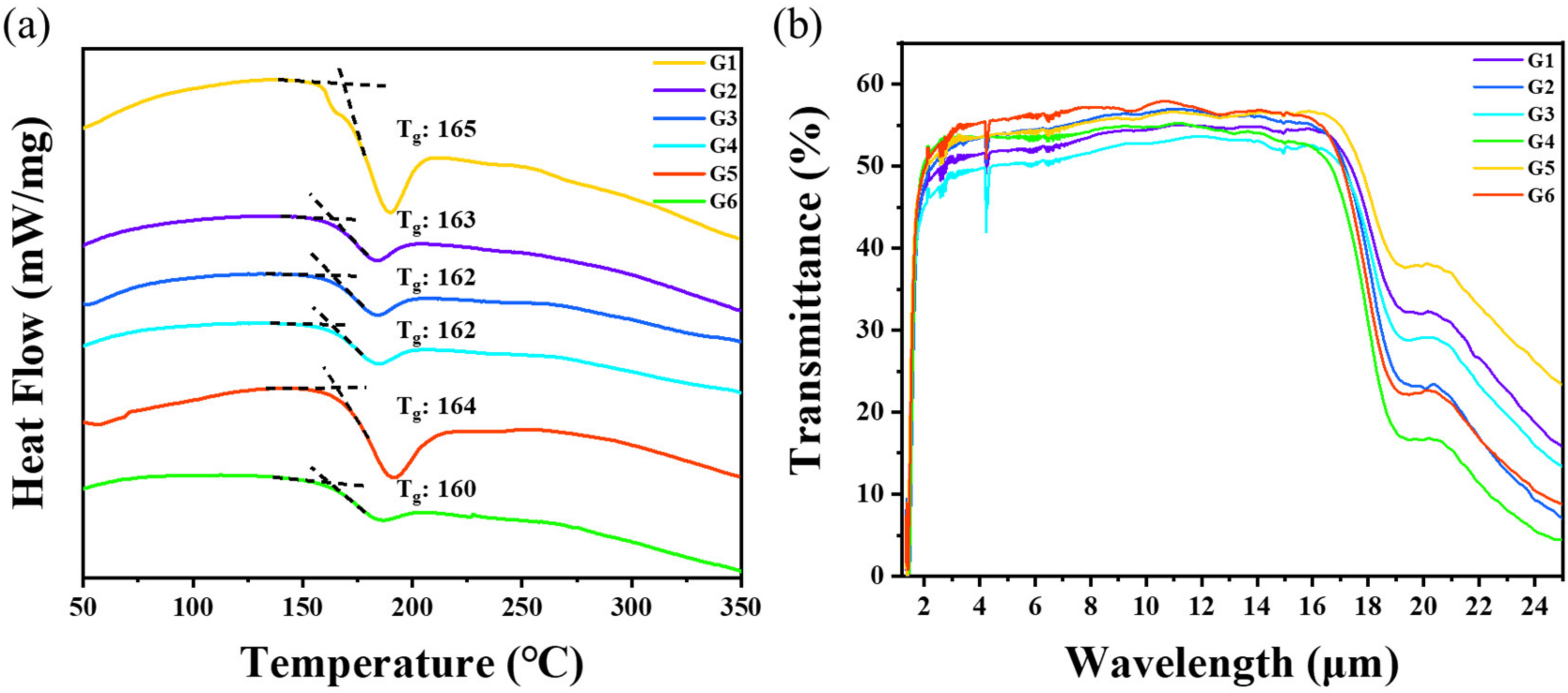
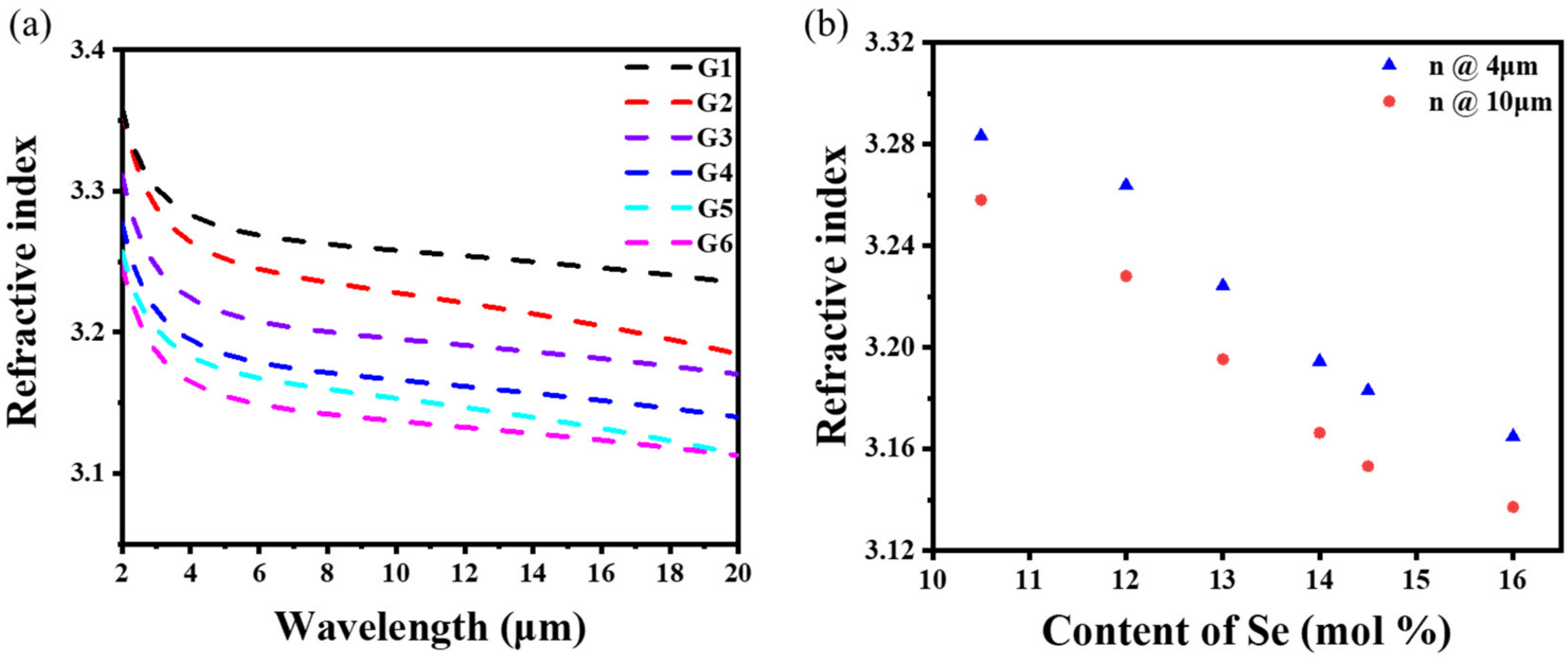
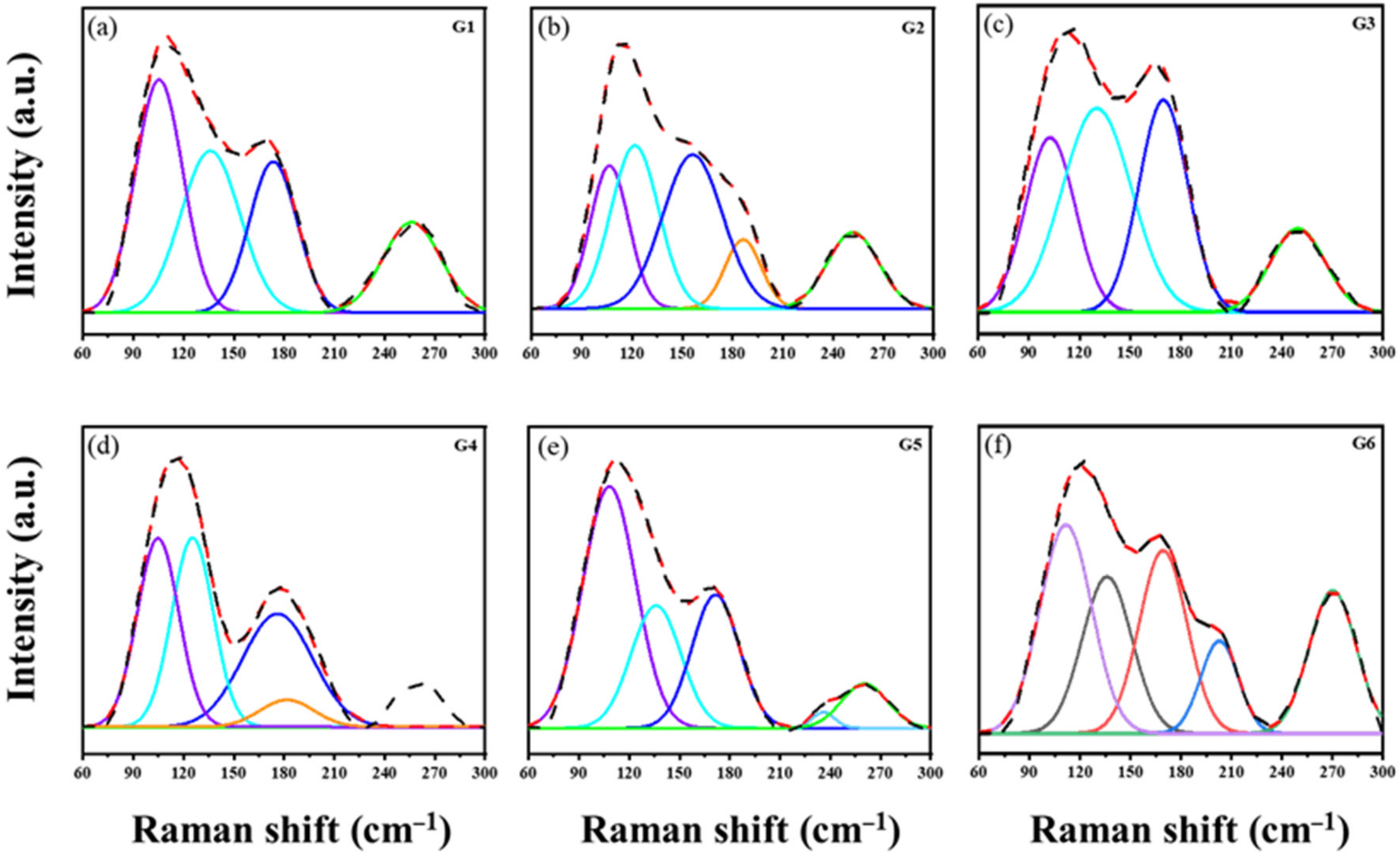
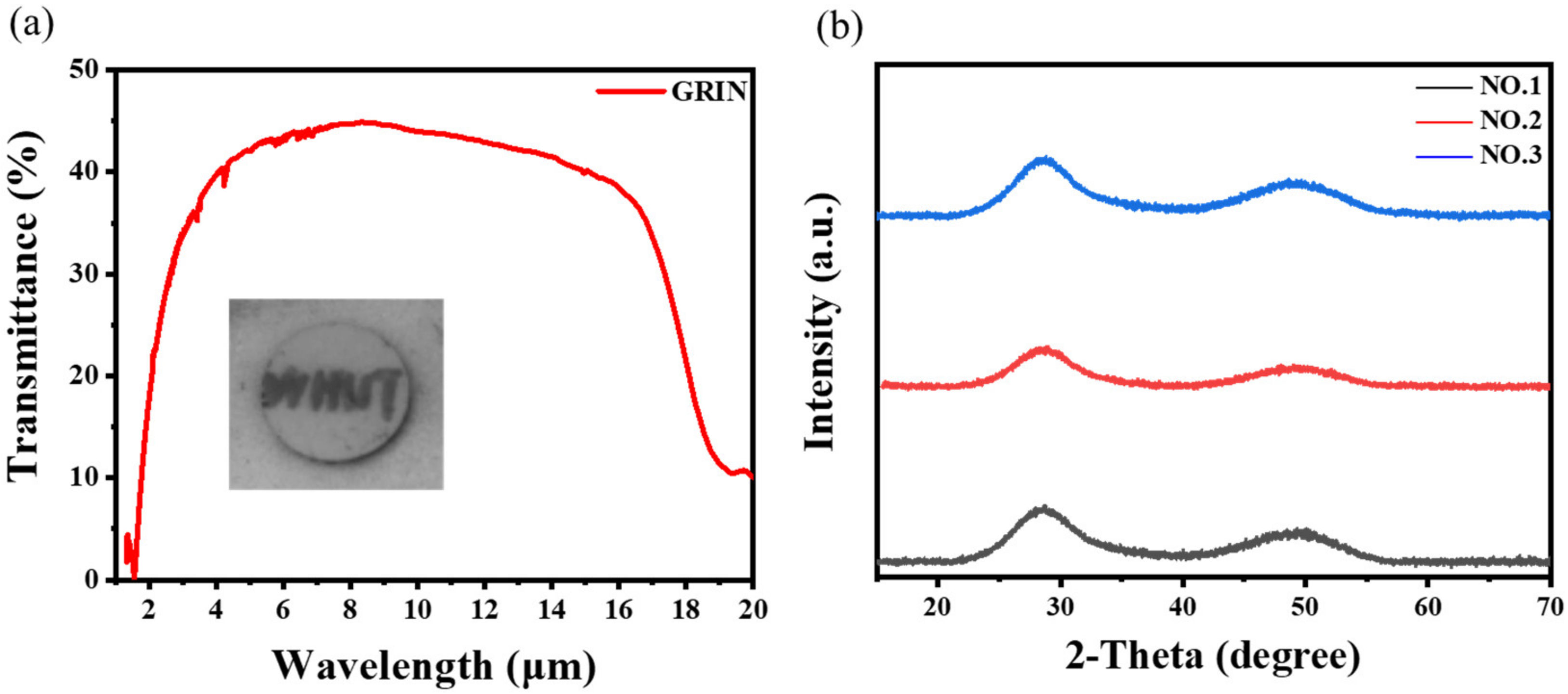
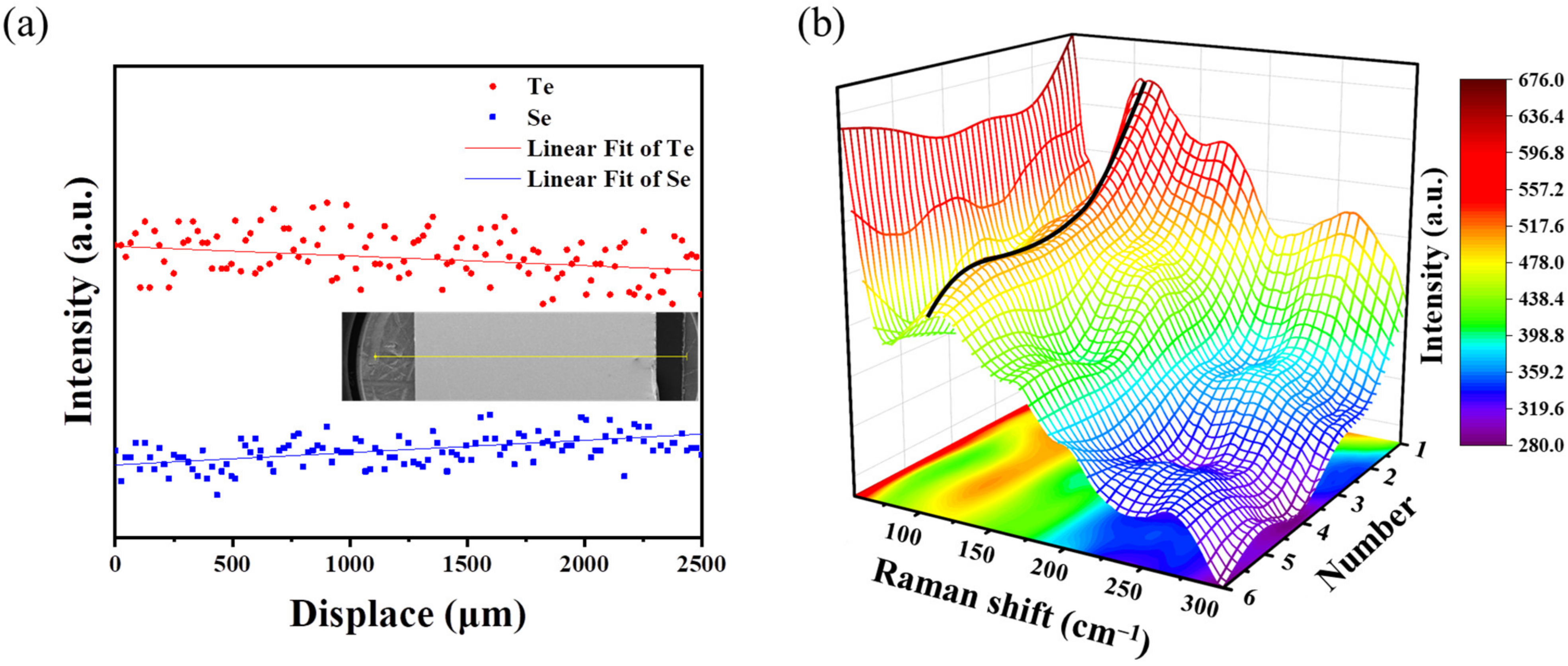
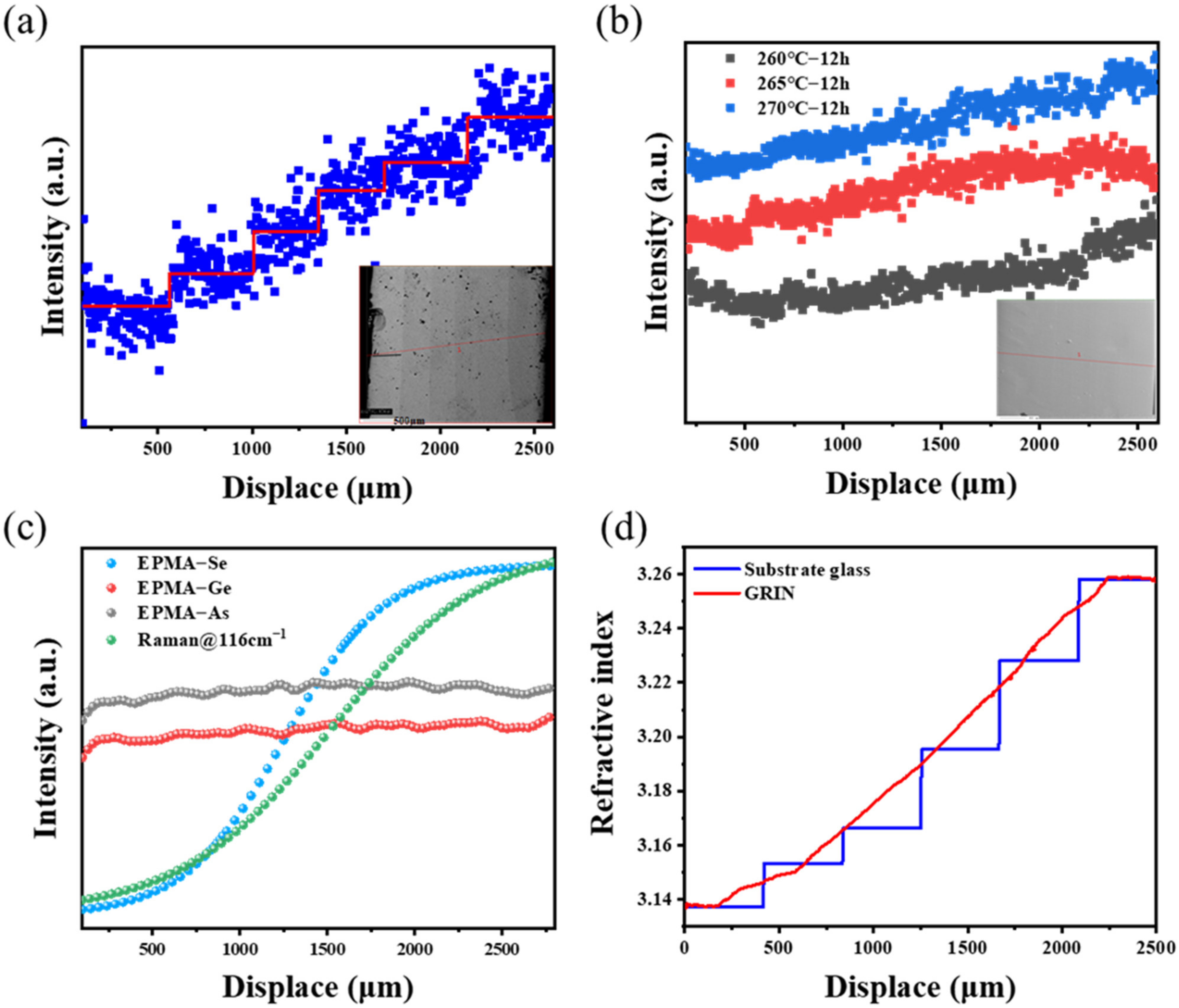
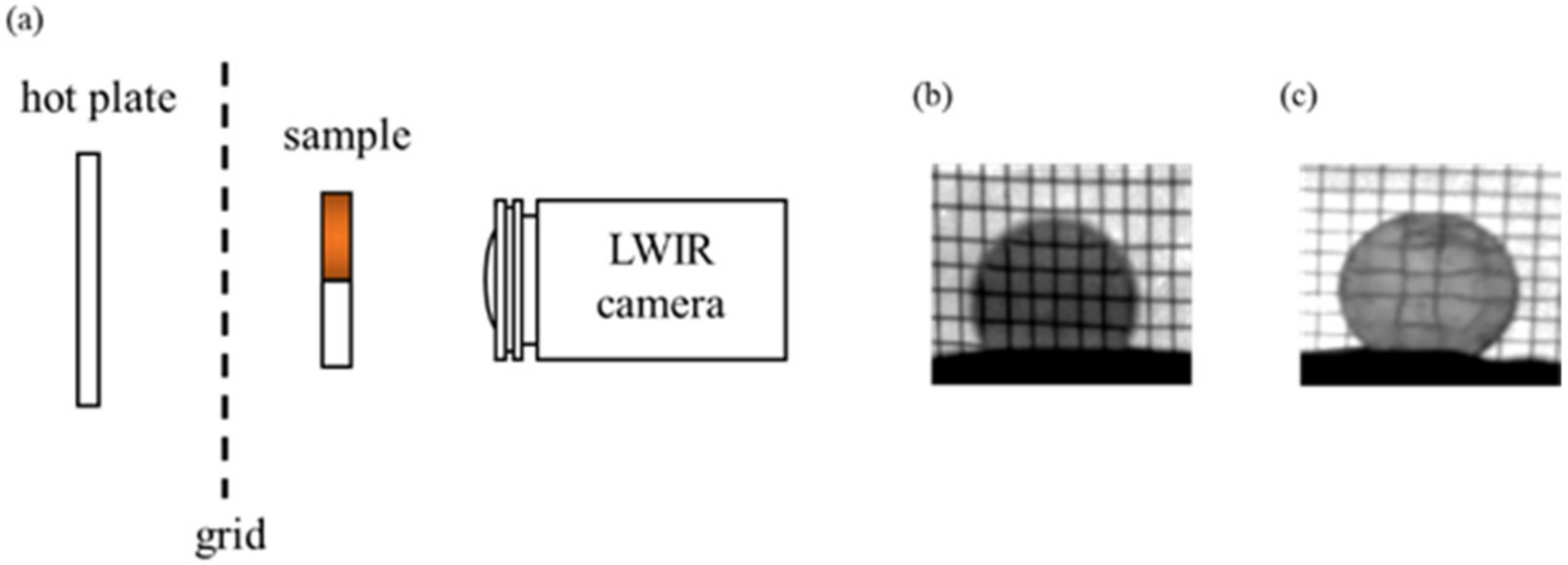
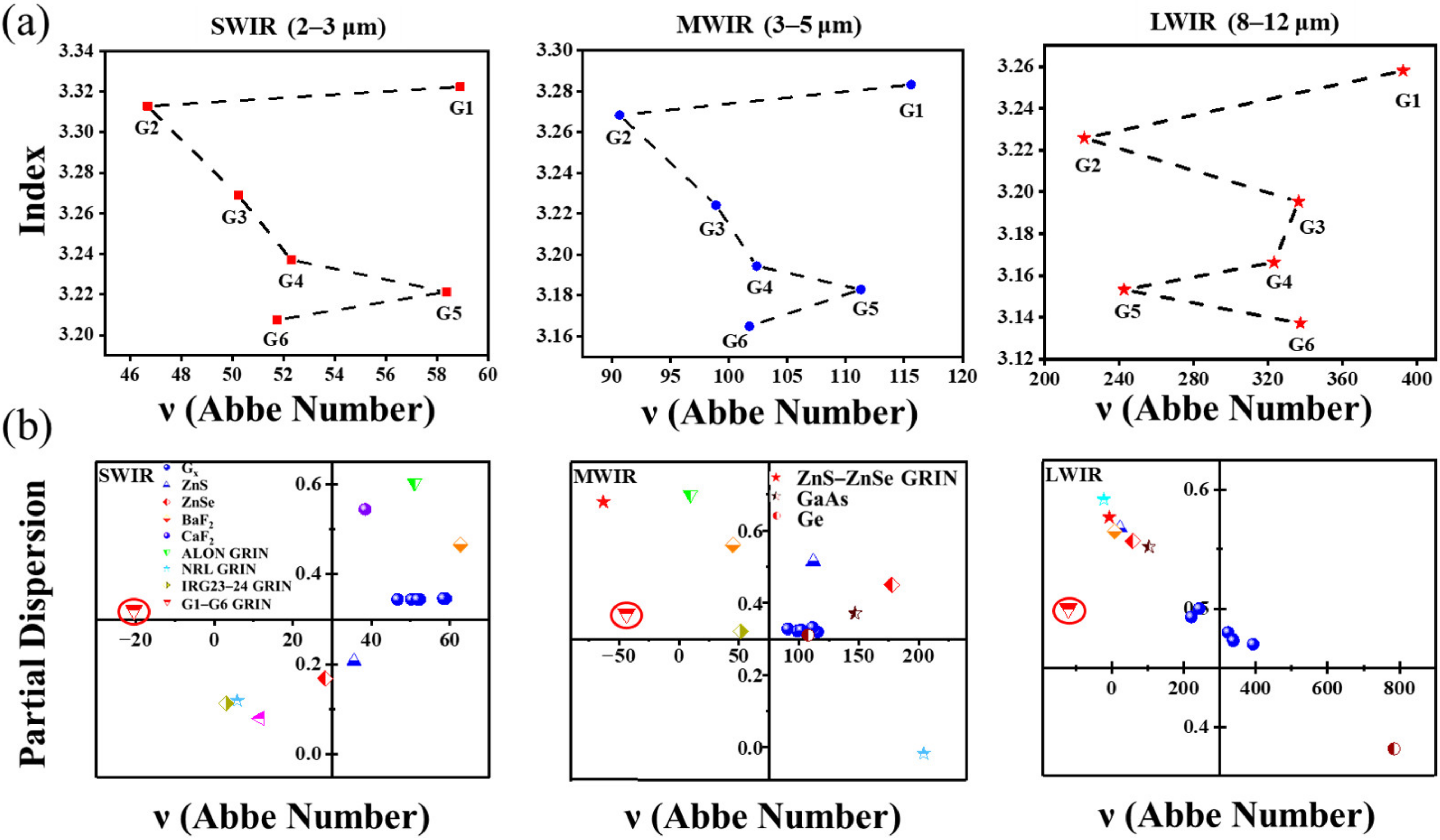
| Glass | Composition | ρ (±0.0001 g/cm3) | n@10 μm (±0.001) | v@10 μm | Tg (°C) | T (±0.1, %) |
|---|---|---|---|---|---|---|
| G1 | Ge17.2As17.2Se10.5Te55.1 | 5.3009 | 3.258 | 272 | 165 | 54.4 |
| G2 | Ge17.2As17.2Se12Te53.6 | 5.2656 | 3.228 | 153 | 163 | 56.5 |
| G3 | Ge17.2As17.2Se13Te52.6 | 5.2469 | 3.195 | 231 | 162 | 52.8 |
| G4 | Ge17.2As17.2Se14Te51.6 | 5.2195 | 3.166 | 221 | 162 | 54.8 |
| G5 | Ge17.2As17.2Se14.5Te51.1 | 5.2190 | 3.153 | 166 | 164 | 56.0 |
| G6 | Ge17.2As17.2Se16Te49.6 | 5.2126 | 3.137 | 230 | 160 | 57.3 |
| Number | Temperature (°C) | Pressure (kPa) | Time (h) |
|---|---|---|---|
| 1 | 260 | 7.5 | 12 |
| 2 | 265 | 7.5 | 12 |
| 3 | 270 | 7.5 | 12 |
| Raman Shift (cm−1) | Assignments of Vibrations |
|---|---|
| 80–100 | Te3 triangular cone antisymmetric stretching vibration |
| AsTe3 triangular cone antisymmetric bending vibration | |
| Bending vibration of the GeTe4 tetrahedron | |
| 116 | Symmetrical tensile vibration of the GeTe4 tetrahedron |
| AsTe3 trigonal cone symmetric bending vibration | |
| 136 | [GeTe4Se4−x] stretching vibration of a mixed tetrahedron |
| 166 | Antisymmetric bending vibration of the AsTe3 trigonal cone |
| 167, 222, 235, 374 | As–As bond vibration |
| 183, 250 | Ge–Ge bond vibration |
| Samples | SWIR | MWIR | LWIR | |||
|---|---|---|---|---|---|---|
| V | P | V | P | V | P | |
| G1 | 58.91 | 0.346 | 115.61 | 0.320 | 392.53 | 0.470 |
| G2 | 46.66 | 0.344 | 90.66 | 0.328 | 221.10 | 0.493 |
| G3 | 50.21 | 0.344 | 98.90 | 0.322 | 336.35 | 0.474 |
| G4 | 52.30 | 0.344 | 102.39 | 0.324 | 323.09 | 0.480 |
| G5 | 58.36 | 0.346 | 111.29 | 0.332 | 242.55 | 0.500 |
| G6 | 51.73 | 0.344 | 101.77 | 0.325 | 337.32 | 0.473 |
| ZnS | 35.60 | 0.207 | 112.05 | 0.515 | 22.87 | 0.568 |
| ZnSe | 28.22 | 0.168 | 177.70 | 0.450 | 57.84 | 0.557 |
| G1−G6 GRIN | −20.50 | 0.321 | −43.81 | 0.370 | −120.9 | 0.500 |
| Ge | 107.51 | 0.311 | 784.54 | 0.382 | ||
| GaAs | 146.77 | 0.371 | 103.13 | 0.552 | ||
| BaF2 | 62.72 | 0.466 | 45.04 | 0.560 | 7.14 | 0.565 |
| CaF2 | 38.42 | 0.544 | ||||
| ALON GRIN | 51.00 | 0.603 | 9.37 | 0.700 | ||
| NRL GRIN | 5.84 | 0.119 | 204.14 | −0.017 | −22.68 | 0.592 |
| IRG23−24 GRIN | 2.99 | 0.113 | 51.59 | 0.321 | ||
| ZnS−ZnSe GRIN | 11.55 | 0.080 | −63.13 | 0.680 | −7.31 | 0.577 |
Disclaimer/Publisher’s Note: The statements, opinions and data contained in all publications are solely those of the individual author(s) and contributor(s) and not of MDPI and/or the editor(s). MDPI and/or the editor(s) disclaim responsibility for any injury to people or property resulting from any ideas, methods, instructions or products referred to in the content. |
© 2023 by the authors. Licensee MDPI, Basel, Switzerland. This article is an open access article distributed under the terms and conditions of the Creative Commons Attribution (CC BY) license (https://creativecommons.org/licenses/by/4.0/).
Share and Cite
Kang, Y.; Wang, J.; Zhao, Y.; Zhao, X.; Tao, H.; Xu, Y. High Refractive Index GRIN Lens for IR Optics. Materials 2023, 16, 2566. https://doi.org/10.3390/ma16072566
Kang Y, Wang J, Zhao Y, Zhao X, Tao H, Xu Y. High Refractive Index GRIN Lens for IR Optics. Materials. 2023; 16(7):2566. https://doi.org/10.3390/ma16072566
Chicago/Turabian StyleKang, Yan, Jin Wang, Yongkun Zhao, Xudong Zhao, Haizheng Tao, and Yinsheng Xu. 2023. "High Refractive Index GRIN Lens for IR Optics" Materials 16, no. 7: 2566. https://doi.org/10.3390/ma16072566
APA StyleKang, Y., Wang, J., Zhao, Y., Zhao, X., Tao, H., & Xu, Y. (2023). High Refractive Index GRIN Lens for IR Optics. Materials, 16(7), 2566. https://doi.org/10.3390/ma16072566







